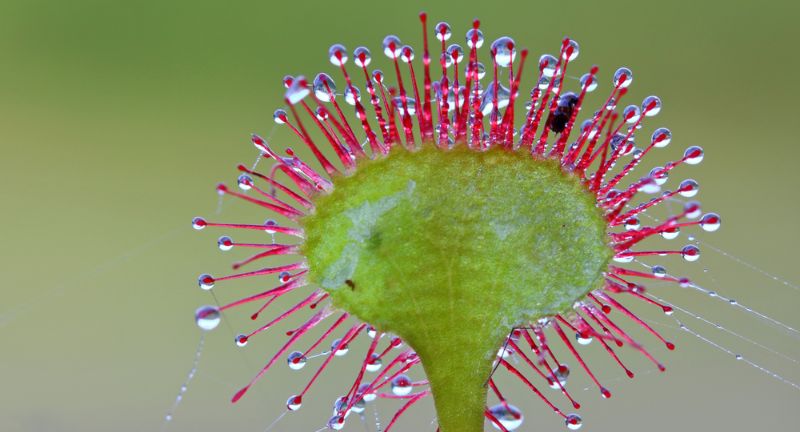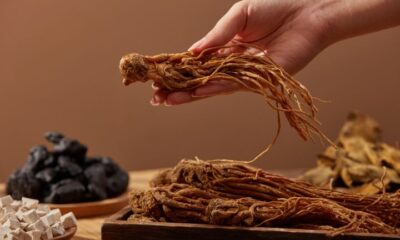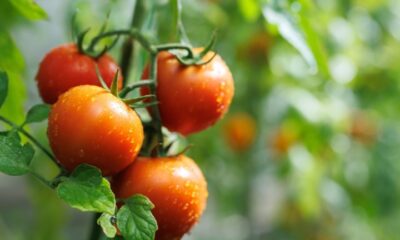EXPLORE
25 Most Beautiful Exotic Flowers In The World
Published
1 month agoon

Shutterstock
Flowers are one of nature’s most beautiful and diverse creations, each variety offering a unique display of colors, shapes, and fragrances. From the lush tropics to the coldest climates, the world is home to a vast array of exotic blooms, each with its own charm and significance. These flowers often hold cultural or symbolic meanings, representing everything from love and beauty to purity and enlightenment. In this collection, we explore 27 of the most stunning and rare flowers found across the globe. Whether you are a gardening enthusiast or simply appreciate the beauty of nature, these flowers are sure to captivate your senses.
Jacaranda

Shutterstock
Native to South America, this tree produces stunning clusters of lavender-blue flowers, often seen in tropical and subtropical regions. The vibrant color of the blossoms creates a breathtaking spectacle when in full bloom, transforming streets and landscapes into a sea of purple. Jacarandas are commonly seen in cities like Johannesburg, Los Angeles, and Sydney. Their ethereal beauty makes them a favorite of photographers and nature lovers alike.
Bird of Paradise

Shutterstock
Known for its vibrant orange and blue colors, this flower is native to South Africa and resembles a bird in flight. Its striking appearance makes it a favorite among tropical gardens, adding bold color and an exotic touch to any landscape. The Bird of Paradise is also symbolic of freedom and beauty, often seen in art and literature. Its unique structure and vivid colors have earned it a place among the world’s most iconic flowers.
Lotus

Shutterstock
Revered in many cultures, the lotus is often associated with purity and beauty. Found in ponds and lakes, its large, pink or white flowers stand above the water surface, creating a stunning contrast against the water’s surface. In ancient Egypt, the lotus was a symbol of rebirth and spiritual enlightenment. In Asia, the lotus is sacred in Buddhism and Hinduism, representing enlightenment and purity.
Orchid (Cattleya)

Shutterstock
Often considered one of the most luxurious flowers, orchids like the Cattleya are native to the Americas and come in a wide range of colors. These exquisite flowers are prized for their delicate, symmetrical petals and intricate patterns. Orchids symbolize beauty, strength, and love, making them popular choices in bouquets and floral arrangements. Their exotic allure and variety of species make them one of the most sought-after flowers globally.
Hibiscus

Shutterstock
A tropical flower found in warm climates around the world, hibiscus features large, showy blooms in a variety of colors, from red to pink and yellow. Often associated with tropical and beachy destinations, hibiscus flowers are widely used in leis and other traditional decorations. They symbolize beauty, delicate femininity, and sensuality in various cultures. The hibiscus is also used in herbal teas, where its petals contribute a tart, flavorful taste.
Plumeria

Shutterstock
Also known as frangipani, this fragrant flower is commonly found in Hawaii and tropical Asia, with its waxy, star-shaped petals. The sweet fragrance of the Plumeria makes it a favorite in tropical gardens and is often used in traditional Hawaiian leis. Plumeria blooms in colors ranging from white and pink to yellow and red. Symbolizing positivity, the Plumeria is often used in religious ceremonies and cultural traditions.
King Protea

Shutterstock
Native to South Africa, this flower has large, spiky petals surrounding a central cone and is often considered the symbol of the country. The King Protea’s dramatic appearance and unique structure make it a showstopper in floral arrangements and gardens. It is highly valued in South African culture, symbolizing diversity and strength. The flower is also the national flower of South Africa, representing resilience in the face of adversity.
Magnolia

Shutterstock
Magnolias are native to Asia and the Americas, known for their large, fragrant white, pink, or purple flowers that bloom in spring. These elegant flowers are highly prized for their beauty and their ability to fill the air with a sweet, fragrant scent. Magnolias have a long history, with their blossoms often seen as symbols of dignity, nobility, and perseverance. They are commonly planted in gardens and parks, where their striking appearance adds charm to any landscape.
Cherry Blossom (Sakura)

Shutterstock
Famous in Japan, these delicate pink flowers bloom in spring, creating breathtaking landscapes in cities and rural areas. Cherry blossoms hold deep cultural significance in Japan, symbolizing the fleeting nature of life and the beauty of impermanence. Hanami, the traditional Japanese custom of enjoying the cherry blossoms, attracts thousands of visitors each spring. The Sakura blossoms are a stunning sight when they blanket parks and streets, creating a serene and peaceful atmosphere.
Titan Arum (Corpse Flower)

Shutterstock
Known for its massive size and strong odor, the Titan Arum is native to the rainforests of Sumatra and blooms infrequently. Its bloom is a rare event that only occurs every few years, attracting crowds of onlookers curious to witness its unusual size and smell. The Corpse Flower’s pungent scent, similar to rotting flesh, is a strategy to attract pollinators such as carrion beetles. Despite its unpleasant odor, the Titan Arum’s sheer size and rarity make it a remarkable flower in the plant world.
Tulip

Shutterstock
Originating from Central Asia, tulips come in nearly every color of the rainbow and are a springtime favorite in gardens worldwide. Their simple yet elegant shape makes them an enduring symbol of beauty and grace. Tulips are often associated with the Netherlands, where vast fields of them bloom each spring, creating vibrant, colorful landscapes. These flowers have also played an important role in history, once being so highly prized that they sparked the famous “Tulip Mania” of the 17th century.
Jade Vine

Shutterstock
Native to the Philippines, this striking flower is a turquoise color that grows in cascading clusters. The unique, almost surreal shade of blue-green is unlike any other flower, making it a showstopper in botanical gardens and nurseries. Jade vines are often found clinging to trees and creating stunning vertical landscapes. Due to their rarity and specific growing requirements, they are considered a rare gem in the world of exotic flowers.
Wisteria

Shutterstock
Known for its long, drooping clusters of purple or blue flowers, wisteria is a climbing vine found in Japan, China, and Korea. When in full bloom, wisteria creates a mesmerizing waterfall of flowers that hang down from trellises or pergolas. The plant is also appreciated for its sweet fragrance, which fills the air during springtime. Wisteria’s graceful beauty makes it a beloved plant in many gardens, often used to create stunning floral arches.
Fuchsia

Shutterstock
A delicate, drooping flower that comes in pink, purple, and red shades, often found in hanging baskets or as part of tropical gardens. Fuchsia flowers are known for their unique shape, with two long stamens and a tubular structure that dangles from the plant. These flowers are commonly found in temperate regions and thrive in shaded areas, making them a favorite in gardens with little direct sunlight. Their vibrant colors and elegant form have made them a staple in ornamental gardening.
Bleeding Heart

Shutterstock
This flower has heart-shaped pink or red blossoms that dangle from arching stems, found in the northern hemisphere. Bleeding Heart flowers are known for their dramatic appearance, resembling a heart with a drop of blood below it. These plants thrive in shaded garden beds and woodland areas, where they add a touch of romance and mystery. Their delicate, drooping form makes them a favorite in perennial gardens and floral arrangements.
Calla Lily

Shutterstock
Elegant and simple, calla lilies have smooth, trumpet-shaped flowers in shades of white, yellow, and purple. These flowers are often associated with weddings and are considered symbols of beauty, purity, and rebirth. Their sleek, modern shape makes them a favorite in both traditional and contemporary floral designs. Calla lilies are native to Southern Africa and are often grown in gardens as both ornamental and cut flowers.
Tropical Water Lily

Shutterstock
Found in the warm waters of tropical climates, this stunning flower has large, round petals that can be pink, purple, or white. Tropical water lilies are an essential feature of water gardens, adding striking color and beauty to serene ponds. These flowers open during the day and close at night, creating a beautiful display of motion in the water. The lily’s soft fragrance and bright colors attract many types of pollinators, including bees and butterflies.
Fallen Angel’s Trumpet

Shutterstock
Native to the Andes, this exotic flower blooms in long, trumpet-shaped structures, typically white or yellow. The large, dramatic blooms of the Fallen Angel’s Trumpet make it a striking addition to gardens and landscapes. This flower is known for its intoxicating fragrance, which is most potent in the evening. While it is visually stunning, the plant is toxic if consumed, adding an air of mystery to its allure.
Cockscomb (Celosia)

Shutterstock
This flower resembles a rooster’s comb and is known for its vibrant, fiery colors of red, orange, and yellow. The unique, ruffled appearance of the petals gives it a striking resemblance to flame-like shapes, making it a favorite in gardens and flower arrangements. Celosia is a hardy flower that thrives in hot, sunny conditions and is often used to add a bold splash of color to any landscape. Its fiery colors symbolize resilience, creativity, and the vitality of life.
Chilean Bellflower (Lapageria)

Shutterstock
A climbing plant with drooping, bell-shaped flowers that can range from pink to deep red, found in South America. The Chilean Bellflower is a rare and sought-after ornamental plant that flourishes in cooler, humid climates. Its beautiful, drooping flowers add a touch of elegance to any garden, and its climbing habit makes it ideal for trellises and fences. Symbolizing resilience, the flower has also been embraced as a national flower in Chile.
Sundew

Shutterstock
A carnivorous plant with delicate, dew-covered leaves that trap insects. Its small, pink, or white flowers bloom in a star-like shape, creating an intriguing contrast against its insect-catching leaves. Sundews can be found in wetlands and other moist environments, where they thrive in nutrient-poor soil. This fascinating plant lures its prey with its sticky, glandular hairs, adding a touch of mystery and danger to its appeal.
Queen of the Night

Shutterstock
A rare, night-blooming cactus flower that opens only at night and features large, white, fragrant blooms. The Queen of the Night is a breathtaking flower that blooms under the cover of darkness, filling the air with a sweet, intoxicating fragrance. Its rarity and nocturnal nature add to its allure, making it a coveted plant among collectors and gardeners. This flower symbolizes mystery, transformation, and the beauty of the night.
Saffron Crocus

Shutterstock
Known for producing saffron, this flower has delicate purple petals and is prized for its culinary and medicinal uses. The Saffron Crocus blooms in the fall, its vivid purple flowers producing valuable saffron threads that are harvested by hand. Saffron is one of the most expensive spices in the world, and this flower plays a vital role in the spice industry. The Saffron Crocus is also known for its potential medicinal properties, used in traditional medicine for various ailments.
Angel’s Trumpet

Shutterstock
A large, fragrant flower found in tropical regions, this plant features trumpet-shaped blooms in white, yellow, or pink. The Angel’s Trumpet is known for its intoxicating scent, which attracts pollinators and fills the air with a sweet aroma. These flowers are commonly grown in gardens for their stunning appearance and pleasant fragrance. However, the plant is toxic, and its beauty comes with a cautionary note, as it can be dangerous if ingested.
African Violet

Shutterstock
This small, perennial flower produces violet-colored, fuzzy blooms and thrives in indoor environments, making it a popular houseplant. The African Violet is adored for its compact size and ease of care, making it a favorite in homes and offices. It blooms year-round, producing clusters of vibrant purple, blue, or pink flowers. The plant symbolizes love, friendship, and loyalty, making it a thoughtful gift in many cultures.
Conclusion

Shutterstock
As we conclude this journey through the world’s most beautiful and exotic flowers, we hope you’ve gained a deeper appreciation for the diversity and wonder of nature. Each of these flowers tells its own story, whether through its vibrant colors, unique form, or cultural significance. From the serene lotus to the bold bird of paradise, these blossoms remind us of the beauty that exists all around us. Whether admired in a garden or celebrated in art, flowers continue to inspire and captivate people worldwide. May these stunning blooms serve as a reminder of the incredible natural world that surrounds us.
Related Topics:

More From Lifestylogy
-


25 Foods That Are High In Protein But Low In…
-


Vintage Photos of Hollywood Icons Unlike You’ve Ever Seen Before
-


25 Herbs That Are Essential To Chinese Herbal Medicine That…
-


Fabulous Fruit: 30 Of Tomatoes Biggest Historical Accomplishments
-


33 of the Most Important Tips for Beginner Gardeners
-


Hardwood Is The Best: Here’s Why
-


24 Uses For Bananas That Are Oddly Practical
-


Relatable Wedding Moments We Know Too Well
-


Your How To Guide To Gardening